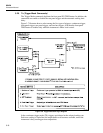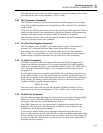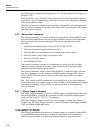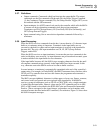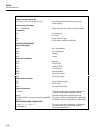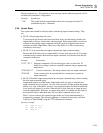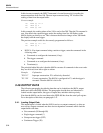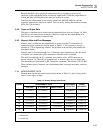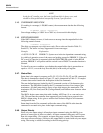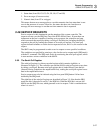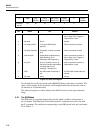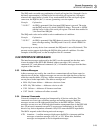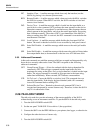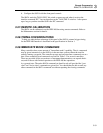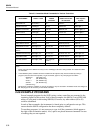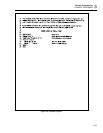
8842A
Instruction Manual
3-26
NOTE
In the fast (F) reading rate, the least significant digit is always zero, and
should be disregarded when interpreting accuracy specifications.
3-45. OVERRANGE INDICATION
If a reading is overrange (≥ 200,000 counts), the measurement data has the following
format:
±9.99999E+9 <suffix> <terminators>
Overvoltage readings (> 1000V dc or 700V ac) do not result in this display.
3-46. ERROR MESSAGES
If the 8842A detects an error, it loads an error message into the output buffer in the
following numeric format:
+1.00xxE+21 <terminators>
The digits xx represent a two-digit error code. (Error codes are listed in Table 2-1,
Section 2.) The suffix is always suppressed for error messages.
Example Explanation
+1.0071E+21 CR LF ERROR 71: Syntax error in device-dependent command string.
As with local operation, none of the errors are latching except for ERROR 31. If the mA
DC or mA AC function is requested while the FRONT/REAR switch is in the REAR
position, ERROR 31 will persist until the switch is set to FRONT or another function is
selected.
To check for an error condition, test whether the output buffer data is greater than or
equal to +1E+21, or test the Any Error bit (bit 6) in the serial poll register.
3-47. Status Data
Status data is the output in response to G0, G1, G3, G4, G5, G6, G7 and G8, commands.
The data is formatted as shown in Figure 3-2, and is interpreted in Table 3-1. Examples
of status data can be found in the description of the Get commands.
The user-defined message loaded by the G3 command consists of 16 characters plus
terminators. The SRQ mask loaded by the G1 command consists of two integers plus
terminators. All other status data is always a four-digit integer plus terminators. The
terminators LF (Line Feed) and CR (Carriage Return) each add an extra character when
enabled.
The 8842A begins some status data with a leading ASCII one (1) or a one and a zero
(10). This prevents the controller from suppressing any leading zeros present in the
8842A’s output string. It also gives a uniform four-character length to all instrument
configuration data.
Status data from the Get commands reflects the status of the 8842A at the time the
command is executed at its place in the input command string.
3-48. Output Priority
Since only one output string is allowed per input command string, the 8842A gives
priority to some types of data over others. An input command string may call for more
than one output string. (For example, an input string may contain a Get command but
also cause an error message.) However, the output buffer is loaded with only one output
string. That string is selected according to the following priority:



